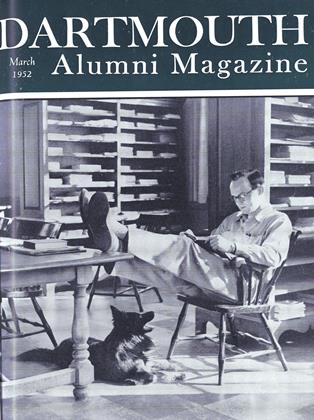NEARLY ten years of scholarly work reaches a tangible climax for Prof. Hugh Morrison '26 this month when the Oxford University Press brings out his new book, Early American Architecture. As the most comprehensive treatment of the subject yet attempted, the book bids fair to be a landmark in the field of architectural history.
In the belief that there are too few scholarly works that cover broad fields, Professor Morrison, who has been a member of Dartmouth's Department of Art since 1933, undertook the monumental task of putting together all that is known about colonial architecture, from the early settlements in St. Augustine in 1565 to San Francisco in 1848. Illustrated with 458 pictures, the book covers the panorama of log cabins, forts, mills, mansions, pueblos, colleges, churches and public buildings; and dramatizes the impact on building of the customs and social changes during the period portrayed. There is a wealth of information on furniture and interiors, and the ingenious methods used by early craftsmen in building and decoration. The major writing of the book was done while Professor Morrison held a Guggenheim Fellowship, in 1948-49.
He began work on his book shortly before World War II, and although interrupted by additional duties during that time, completed an outline and made a tentative selection of the pictures he wanted to use. A primary objective was to have the pictures tie in with, and point up, his text: a help seldom given by writers on architectual subjects. His choices were made from more than 100,000 pictures. Except for some work at the Library of Congress, where Professor Morrison covered the entire collection of the Historic American Buildings Survey, and except for four book loans from institutions away from Hanover, he found the bulk of his pictures and material right at Dartmouth, where the Carpenter Hall and Baker Library collections in the architectual field are outstanding.
After he had completed the writing and checking of his text, he was faced with the task of obtaining the original photos of the pictures he desired. He had made small copies of most of them with his own camera, with notations as to where they were published, and over 400 letters were then mailed to photographers, museums, and historical societies. Still more time went into working directly with the Oxford University Press in New York in order that the pictures correlate with the text and appear on adjacent pages.
Besides photographs, Early American Architecture has numerous plans and structural details drawn by Philip A. White '37, as well as maps done by Van English, Assistant Professor of Geography, at Dartmouth.
An earlier book by Professor Morrison, Louis Sullivan: Prophet of Modern Architecture, was published in 1935. Widely acclaimed, it was recently reprinted by Peter Smith. Following his graduation from Dartmouth, Professor Morrison received the Master of Arts degree from Princeton in 1928, and was instructor in art at the University of Chicago from 1927 until he came back to Dartmouth in 1933. He was made a full professor in 1938. "Introduction to Architecture" and "American Architecture" are two of the art courses he now teaches.
PROF. HUGH MORRISON '26
 View Full Issue
View Full Issue
More From This Issue
-
 Article
ArticleAround the World in Fifty Books
March 1952 By JOHN HURD '21 -
 Article
ArticleTelevision and Education
March 1952 By EDWARD LAMB '24 -
 Class Notes
Class Notes1918
March 1952 By ERNEST H. EARLEY, DONALD L. BARR, RICHARD P. WHITE -
 Class Notes
Class Notes1929
March 1952 By F. WILLIAM ANDRES, EDWIN C. CHINLUND, JACK D. GUNTHER -
 Article
ArticleThe Undergraduate Chair
March 1952 By Conrad S. Carstens '52 -
 Class Notes
Class Notes1923
March 1952 By TRUMAN T. METZEL, COLIN C. STEWART 3RD
Article
-
 Article
ArticleMasthead
-
 Article
ArticleConcert Series
December 1933 -
 Article
ArticleGifts from the Old Guard
April 1940 -
 Article
ArticleThayer Dean Elected
December 1945 -
 Article
ArticleProphet of the North
Sept/Oct 2007 By Alexander NazarYan '02 -
 Article
ArticleHistorical musings: Mitchell '32 on Occom and Haynes
JUNE 1983 By Robert W. Mitchell '32

